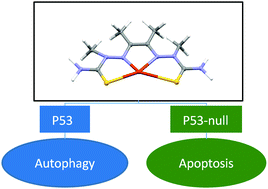Autophagy and apoptosis: studies on the effects of bisthiosemicarbazone copper(ii) complexes on p53 and p53-null tumour cell lines†
Abstract
A comparative study between two bisthiosemicarbazones, 2,3-butanedione bis(4,4-dimethyl-3-thiosemicarbazone) and 2,3-butanedione bis(2-methyl-3-thiosemicarbazone), and their copper(II) complexes is reported. The four compounds have been tested on a leukemia cell line U937 (p53-null) and on an adenocarcinoma cell line A549. The study includes cell viability, cell cycle, morphological changes, assessment of apoptosis, analysis of autophagy, measurement of reactive oxygen species (ROS) and of lipid peroxidation, protein determination, assessment of the expression of p53 and cellular uptake of metal complexes. Tests about the copper uptake under normoxic and hypoxic conditions were also carried out on a solid tumour cell line A549. The four compounds under study elicit different effects on the two lines adopted as representatives of p53 and p53-null cells. The role of the metal is relevant and it is likely that the metal-mediated oxidative stress plays an essential role in the whole process. The mechanisms induced by these molecules differ not only as a function of the cell line but also of dose. The responses include two distinct self-destructive processes, autophagy and apoptosis.



 Please wait while we load your content...
Please wait while we load your content...